How do those who thought that premodern cultures were on the way out and modernity was the definitive road to prosperity feel today, now that we “moderns” are in fact on the verge of extinction?
There were the Amazonian peoples, the Inuit… I don’t know how much they really mattered in certain circles, but in any case everybody seemed to be rather sympathetic to their fate, they took it as an inevitable destiny of decay and disappearance, they were going to be taken over by a progress that all things considered would be good for them, would bring them cures and comfort and freedom from the natural state, poor things…
A bit like artisans. In the age of financial capitalism, which had taken the place of industrial capitalism, few people knew what to do with these worlds defined as endangered, except in advertising which, as we know, was full of lies. Hermés and Cucinelli have found a way, in fashion, to truly integrate the capital that craftsmanship and traditions represent. But in the common understanding, craftsmanship has become synonymous with the shabby and imprecise: sorry, this object is a bit imperfect, you know, it’s hand made… as if things made in an industrial way were perfect! Apart from the fact that even if they were perfect, the geniuses of programmed obsolescence would take care of depriving them of this inhuman characteristic. Besides, premodern is also generally understood in a diminutive sense. Beyond the narrow circles of scholars and thinkers (many of us would not call ourselves thinkers, we are more like repeaters of other people’s thoughts, we are thought rather than thinking, and we are often not even aware of it), the premodern are the primitive, Darwinian-like primates.
It took someone from Arcigola to make us think of the primitives as masters.
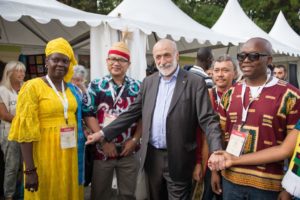
With Terra Madre, the world’s farmers were invited as government delegations and heads of state. I can still remember the first time: 5,000 farmers and breeders, in Turin, the city of the automobile and national captain of industry, one of the symbols of the 20th century. Terra Madre populated the streets of Turin with Peruvian, Burkina, Occitan and Uzbek farmers, with calloused hands and traditional costumes, who replaced playboys and oil men in convertibles. People saw them as exotic. There were many of us who didn’t understand that Petrini was telling us “guys, let’s learn from these peoples, who have been on earth for centuries, we, the modern ones, have not even been here for two hundred years and probably won’t be for much longer, if we continue like this we will in fact soon become extinct…”. It took years before we understood that the concept of anthropocene means antropoceneannamo (i.e. we’ll soon be going)! It doesn’t translate into English or Chinese… but in Romanesco it’s very clear!
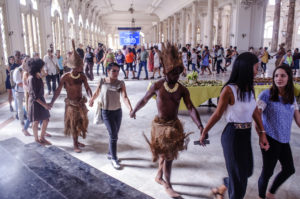
Now we need to have two, three, ten Terra Madres: of food, which already exists, of clothing, of mobility, of waste, of energy, of politics, of technology, of forests, of air and of mountains.
It is not about going backwards. We need to examine everything and sift apart what is on the side of life and regeneration and what is on the side of extraction and annihilation, we need these sieves for nuggets and straws of human intelligence like care, custody and sustainable invention. Who has them? Where can they be found?
First of all, there is no patent on these sieves, which is the reason why economists do not see them (although they would try to patent them). Economists, like statisticians, only see recognisable data. They are like Facebook algorithms, they only see what they already know. No wonder they are convinced by their own ideas. And that other people’s ideas seem crazy to them!
We have to learn how to make these sieves, to invent them, because every situation will require different ones; everything is located, if we stay on the planet, which to tell the truth we tend not to do much, we prefer to transcend towards a religious or military elsewhere. Conquering space is obviously a profitable mine: instead of digging into the ground, we open trajectories upwards, towards Mars for example. Even before we actually get there and make money from the mines we’ll dig there, we are in fact exploiting the business of preparing to go there.
But if we could learn something from these primitives (as we used to call them, today I would call them masters), we could deal with the laws of circularity, harmony and regeneration instead of thinking about Mars, thus preparing to leave the junk Earth to a lost humanity.
Science, technology and even bureaucracy could put a lot of good things on the table, to help us run a society in dynamic balance with Gaia.
This is the project concept of the Third Paradise, symbolised by the three circles now appearing in thousands of temporary or permanent installations and occurrences.
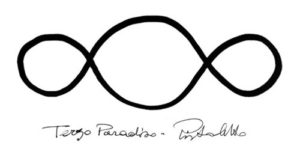
Here, the side circles represent two existing and different elements, even opposites. In the middle there is an empty space, where to cultivate – like farmers – the soil of creation and regeneration, which holds together the reasons of both pre-existing elements, combining them in new arrangements, and therefore creates, operating in dynamic balance, always in ferment.
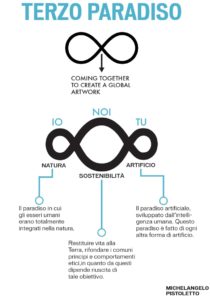
We see it in these images, permanently installed at the United Nations headquarters in Geneva, or in a temporary and very rare manifestation of the Louvre pyramid.
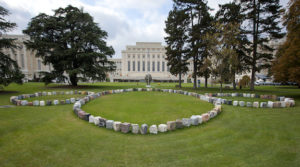
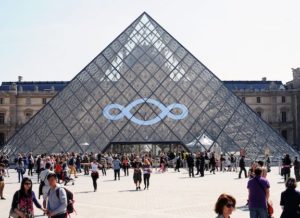
This is the formula that the art foundation created by Pistoletto in the 1990s has forged and has been experimenting with in dozens of working sites and urban and territorial design workshops. Not only in Biella, but also in Havana, Cuba, Rome, Melbourne and Sao Paulo, to name but a few.
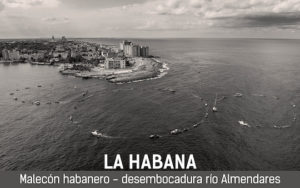
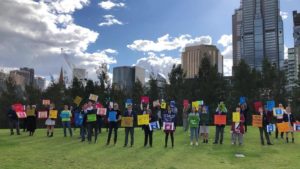
Our network of artists and activists and civil innovators, i.e. artivators, is carrying out this work of invention rooted in the substratum formed by the union of the intelligence of nature with that of man, like in the perfect synthesis of the so-called bio-mimesis; just think of the Blue Economy, founded by Gunter Pauli, who is now an ambassador of the Third Paradise.
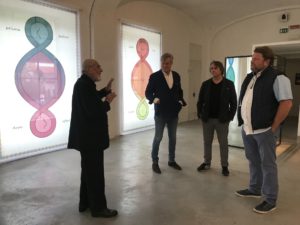
Or like on the Isle of Skye, where Cooking Sections, a collective that teaches as mentors in the courses of Cittadellarte’s school, Accademia Unidee, has developed the project Climavore: the menus of the restaurants on the Isle of Skye, in Scotland, have replaced farmed salmon (whose impact on the ecosystem is profoundly unsustainable) with mussels and oysters reared in a sustainable and above all regenerative way, with a positive impact.

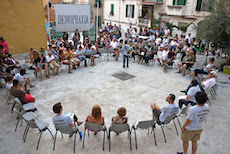
It is an art of continuous new balances and creations.
In Biella, where Cittadellarte is, this art is studied, taught and experimented with; Pistoletto and I have condensed it into a small manifesto called The Art of Demopraxy.
The individual organisations of the social body exercise power through doing, precisely through practice. The space defined by the decision-making capacity of the single company or association, of the institutional office, of the body, of every agglomeration of people united by the exercise of a practice is able to determine a profound impact on the lives of the people that compose this community of practice. Decisions that affect the economic and material spheres (e.g. type of contracts and remuneration, working hours, type of supplies and provisions on which to base the value chain…), as well as the emotional dimension and the realisation of our human potential, as in the theory of capacities of Amartya Sen and Martha Nussbaum.
Happiness or frustration in our lives come primarily from these territories, not only from national and territorial governments.
So if localised ecologies already determine a large part of the world governance, how can this governance be oriented towards the common good?
At Cittadellarte we have developed a method, which is the art of demopraxy.
Let’s then see how Cittadellarte operates in the civic and urban fabric of the territory. In fact, everything Cittadellarte has carried out in Biella since the ’90s has been in the wake of the vision of the Third Paradise, and here is where the Demopractic Work started in 2019. A meeting called Prelude for a Choir was held in October, with the participation of over thirty key players from the area.
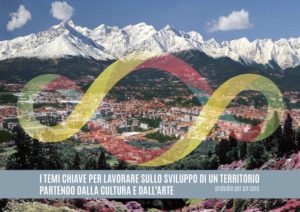
Pierluigi Sacco accompanied us by framing the many different voices in a score oriented towards a well-being in which culture, happiness, prosperity, sustainability are different ways of saying (and doing) the same thing.
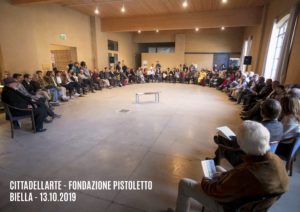
It is the beginning of the canovaccio of the Demopractic Work. The First Scene is represented by the youth associations which, trained by Cittadellarte’s curators and educators, map over 100 organisations of the territory engaged in hospitality, production, education, administration, culture, in line with the objectives and targets of the UN 2030 Agenda for Sustainable Development. We are in full lockdown: mapping is mostly done online, with video calls. However, as well as oral and visual testimonies, objects are also collected.

They will be used for the Exhibition, the performative outcome of the First Scene. The Demopractic Work attracts the interest of young people. This promotes the self-acknowledgement of local actors as champions – and the one of the youths as talent scouts – of a wealth of social capital to be discovered, but also to be communicated and organised in a vision that gives identity to the territory and can become a collective project.
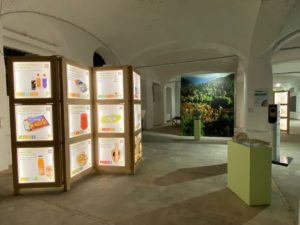
The Demopractic Work has thus entered the phase of the Exhibition, created with the contribution of a new player: Fondazione BIellezza, cause and effect of the climate of unrest that is increasingly felt in the Biellese area. The first two sectoral forums are already taking shape, dedicated to Energy and Water. The Exhibition welcomes the operative device of the Demopractic Tables.
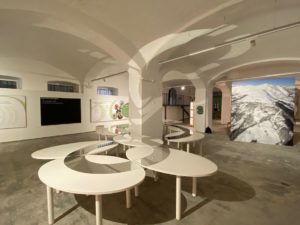
The Tables are designed by Pistoletto and Saverio Teruzzi, already active in Rome’s Working Sites, and in Geneva, in the collaboration with Fondazione Mater and Food for Soul.
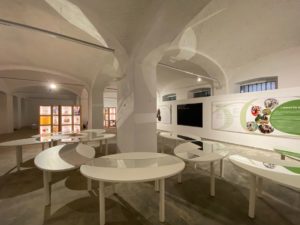
This is how Cittadellarte is developing the Demopractic Work in Biella.
In fact, this was already happening ante litteram, since Cittadellarte has always been conducting a social artistic work in the area. So much so that, in 2019, UNESCO nominated Biella as a Creative City.

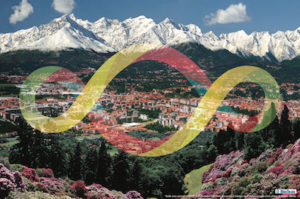
Not something you would have taken for granted in the ’90s, when the foundations of Cittadellarte were laid in the abandoned buildings along the river in the city centre. Not even in the early 2000s, when hundreds of Unidee students were learning the art of activating processes of social transformation based on responsibility. In those years another thing happened: the citizens of Biella were also living experiences in which socially engaged creativity represented a meeting ground. Artisans, entrepreneurs, teachers, associations, trade unions, doctors, sportsmen, politicians, administrators, students, families… all of them (all of us) became students. A full-scale experiment of a “city of art”.
Hence the shift from Cittadellarte to city of art. Twenty years of art practices to connect the different fields of human activity and knowledge. The construction of co-creation spaces where everyone has the right to asylum, citizenship and ability. A political and civic programme of immense scope, but also made up of minimal, often minute elements: benches and resting areas in public and private spaces, gardens co-cared for by the inhabitants, land reclaimed for farming, fabrics used for the production of clothing championing sustainability, football matches between employers and employees joined two by two by six meters of fabric, explorations and re-appropriation of natural or artificial spaces, studies and research on the “history and archaeology of the future”, and indeed hundreds more of live experiments.
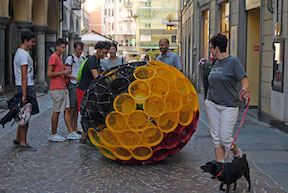
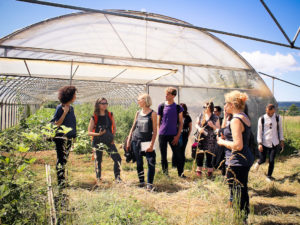
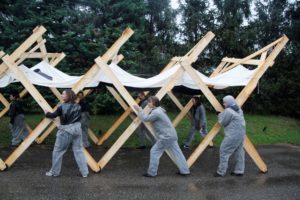
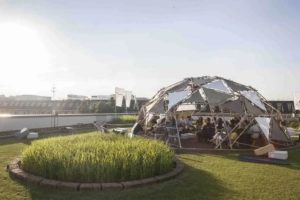
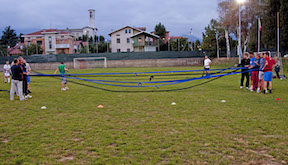
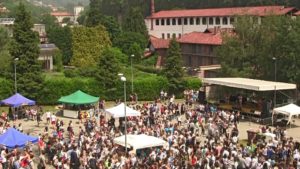
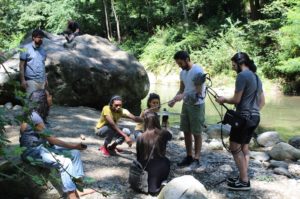
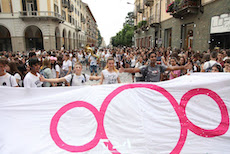
It is therefore not surprising that, also for this reason, an industrial district in transition is designated as creative by the largest global organisation dealing with education, science and culture. This has led to the “archipelago city”.
I would just like to recall how the concept we devised eventually developed into the first edition of a festival of sustainability and creativity, with a full programme starting with the Forum of UNESCO Creative Cities, in collaboration with the National Coordination of the network of UNESCO Creative Cities.
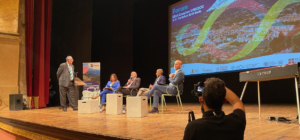
Through the art of demopraxia, a workshop of shared territorial planning is being conducted in the Biella area, based on the devices of mapping and exhibition, of tables and working groups, which will lead to a multi-year working site, articulated on the various emerging themes: for example, an observatory on water has already been set up, bringing together the health director and founder of the Association Textile and Health, the local Industrial Union, researchers from the CNR, operators from the municipal subsidiary, scientists from Turin’s Polytechnic, sociologists, curators, artists and members of the Cultural Heritage and Landscape Observatory, as well as a table on the de-carbonisation of the entire provincial territory.
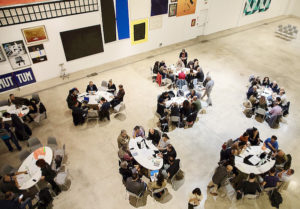
Silicon Valley is on the verge of extinction, it is a bit like Dylan’s rolling stone, he and Bezos are like Edie Sedgwick, do you remember her? The beautiful meteor, a muse they said, perhaps in fact Andy Warhol’s companion, many wanted to be like her, and Dylan asked her how it felt to fall and roll with nothing left? Now Edie is the global digital financial capitalism, the surveillance and the big data. They will end up rolling like a rolling stone. But unlike the beautiful Edie, who died alone, or with half a generation of hedonists, this time we will all die out! We won’t be able to stand on the road and play in the morning and at night.
Could we just let Silicon Valley die out? The fact is that before Zuckerberg disappears rolling downhill, it would happen to a lot of other people with less means and lifeboats, like rockets to Mars or something, which are in fact already being built with the money we could devote to enzymes, sieves, demopraxia… but anyway, the problem is that when Google and Amazon become extinct, most of us will already be well and truly dead. So, we’d better save them. From themselves, that is; and to do that we need masters, who are the premoderns and the scientists together. We need to make room for them, to build places where they can meet with each other, with representatives of all the constituencies that make up the social fabric, in every locale. We don’t only need a G20, but a G1,000, G1,000,000, G1,000,000,000, because this game is being played in each of our communities of practice. This means rewriting a constitution that has never been written but has been practised for thousands of years, made up of the deepest intelligence and humility, found in the Colombian Amazon as well as in the Alps, the inland areas…
Thanks to these spaces of cocreation, we will save Zuckerberg and Elon Musk from extinction. And with them we will save us all.
Let’s start by building empty places. Empty spaces between full spaces. Like the symbol Pistoletto and Cittadellarte are promoting around the world. And we invite artisans and shepherds, financiers and mathematicians, philosophers and policy makers, administrators and bureaucrats, and yes, even politicians, because in reality, this road is the road of politics, politics is the coming zeitgeist.
Politics is the new green.

Yes, politics, but demopractic politics, not the politics of the past, the message is otherwise clear: antro po… ce ne annamo!

